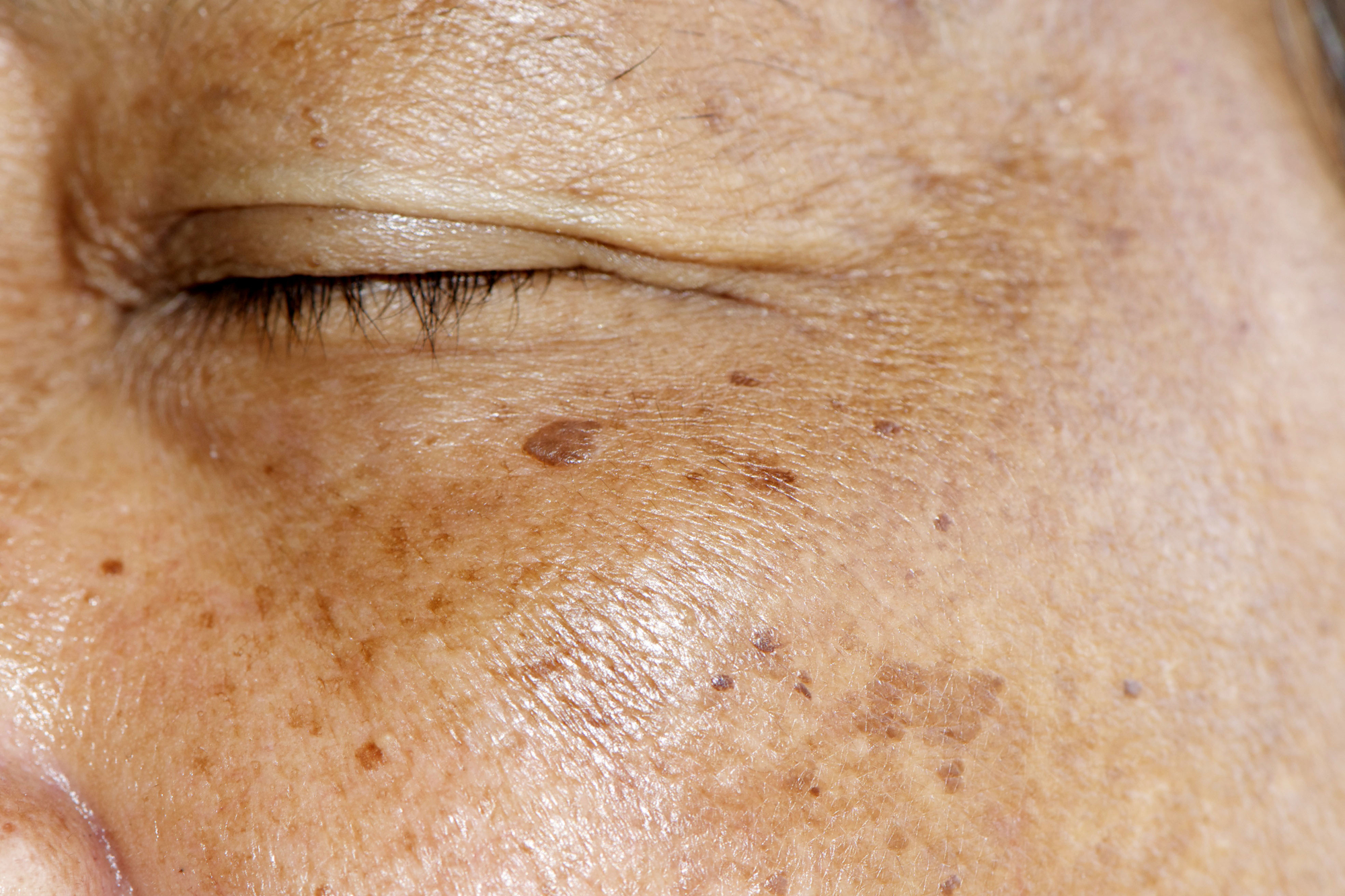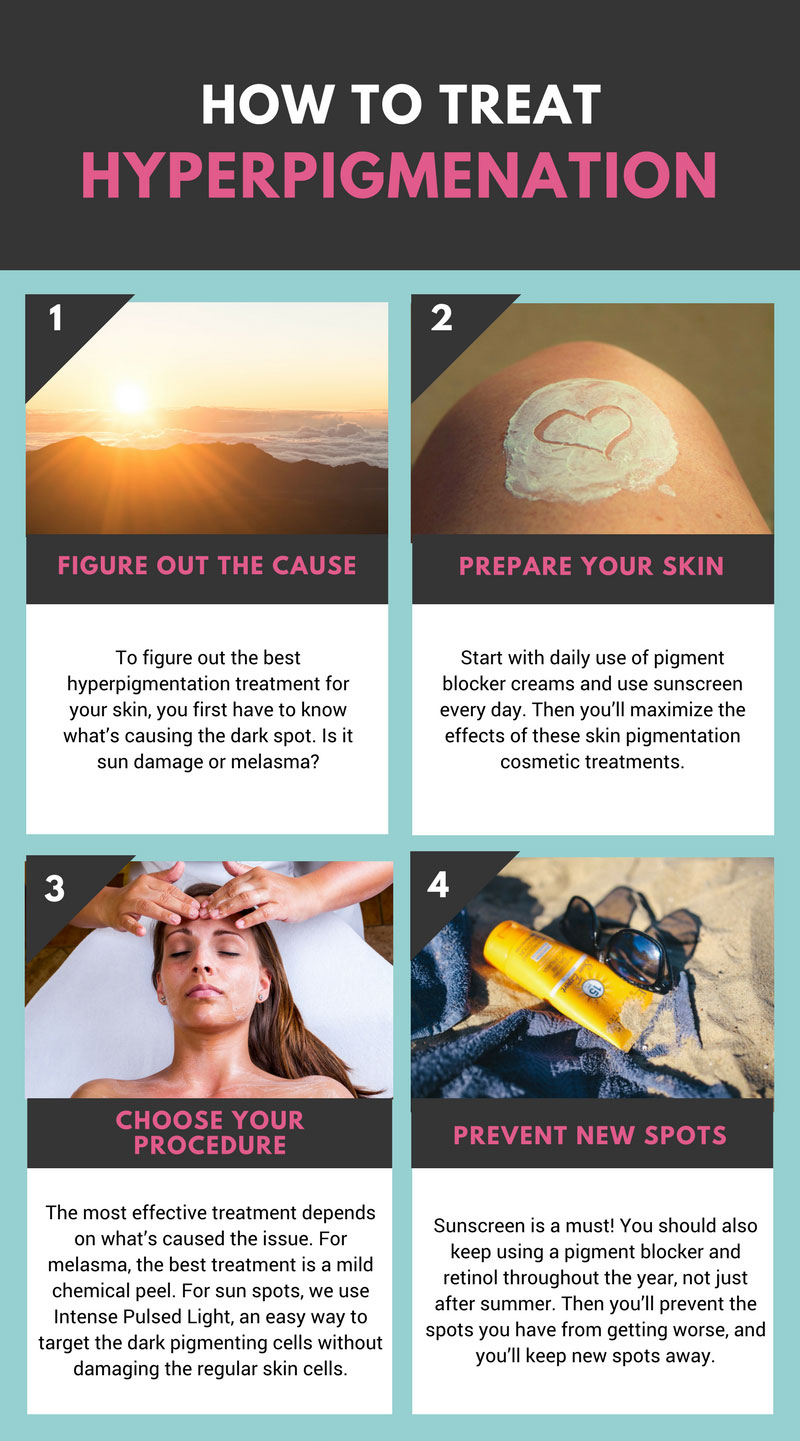Summer time is over. You’ve enjoyed your time outside — days at the lake, relaxing by the pool, enjoying the park. But even though you used sunscreen, your skin has still suffered from some damage. As your skin got a little darker, so did your age spots and melasma. So what can you do about those spots?
1. Figure Out the Cause
To figure out the best hyperpigmentation treatment for your skin, you first have to know what’s causing the dark spot. Is it sun damage or melasma? Melasma is a condition caused by hormones, but exacerbated by the sun. Hence, we have to treat it differently than regular sun damage. That’s why it’s important to get to a skin care professional — the sooner you get the right diagnosis, the sooner you’ll find the right treatment.
2. Prepare Your Skin
If you want to make those brown spots disappear, you’ve got to get your skin ready. With both sun damage and melasma, start with daily use of pigment blocker creams. And use sunscreen every day. Then you’ll maximize the effects of these skin pigmentation cosmetic treatments. The pigment blocker reduces the amount of pigment the skin produces, while the sunscreen blocks the sun from causing more pigmentation.
At night, use a retinol product. Retinol causes the skin cells to turn over. That begins the process of removing the pigmented cells that are there. As you peel off the dark spots, your skin replaces them with normally pigmented cells.
Learn more about retinol: Does Retinol Live Up to the Hype? Here Are 5 Things You Need to Know About the “Miracle” Product
You end up with a three-pronged approach: a sunscreen to block the sun, a pigment blocker to help the skin produce less pigment, and retinol to help heal the skin and remove the skin pigmentation that’s already there. Some hyperpigmentation removal techniques can actually cause the pigment to get worse if you haven’t prepared the skin properly.
So keep all three preparation techniques in mind: pigment blocker, sunscreen, retinol. After three to four weeks of this routine, you’ve optimized your skin condition for treatment.
3. Choose Your Procedure
Now, we distinguish what treatment will work best for your specific condition. Your options range from various types and strengths of chemical peels to laser treatments. The most effective treatment depends on what’s caused the issue.
Melasma
Melasma, the “Mask of Pregnancy”, is triggered by either pregnancy or with the use of birth control pills. It’s a hormone-driven hyperpigmentation on the face that usually leaves large patches of dark areas over the forehead and cheeks.
For melasma, the best treatment is a mild chemical peel. But make sure your skin is prepared. If you haven’t prepared the skin, the hyperpigmentation can become darker and wider after the chemical peel.
Using chemical peels for melasma takes a while — it’s a process that shouldn’t be rushed. By removing the pigment slowly, we prevent the pigment from becoming worse. Strong chemical peels can damage the skin enough that the skin wants to rebound and create more darkness and more pigment. So prep your skin and take it slow.
Related: Living With Melasma: Treatments and Triggers
Sun Spots
Brown spots, like age spots or freckles, are small, flat areas no bigger than the tip of your finger. We treat those spots with Intense Pulse Light treatments. IPL treatments are an easy way to target the dark pigmenting cells without damaging the regular skin cells. These treatments deliver energy to darkly pigmented cells. Then those cells die and flake off. The cells without the dark pigment don’t absorb the energy.
Chemical peels can also be effective with sun spots but sometimes require several treatments. If you choose this route, preparation is key.
4. Prevent New Spots
You had your fun in the sun, but was it worth the skin damage? No matter how extensive your time outside, establish some routines to keep your skin in good condition. Sunscreen is a must — but don’t choose your product haphazardly. Choose a lotion product with enough SPF to keep damage away, and always reapply.
Related: Which Sunscreen SPF Is Enough for Your Skin?
And even though sunscreens are a big help — they aren’t perfect. Keep using your pigment blocker and retinol throughout the year, not just after summer. Then you’ll prevent the spots you have from getting worse, and you’ll keep new spots away. Remember, this is a battle against hyperpigmentation — there’s no one-time fix. So ready yourself with your arsenal of pigment-fighting products and get started eliminating those brown spots.

Dr. R. Todd Plott is a board-certified dermatologist in Coppell, Keller, and Saginaw, TX. His specialization and professional interests include treating patients suffering with acne, identifying and solving complex skin conditions such as psoriasis, rosacea, atopic dermatitis, and identifying and treating all types of skin cancers. In his spare time, Dr. Plott enjoys cycling, traveling with his wife, and spending time with his children and new grandson.
Learn more about Dr. Plott.


